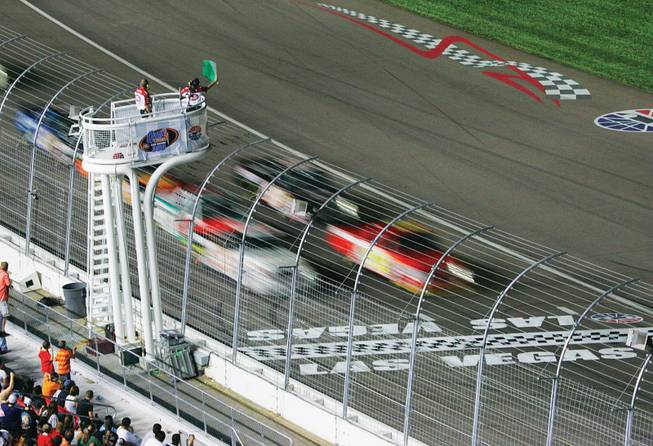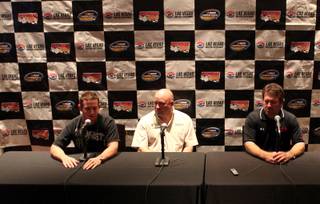
SAM MORRIS / LAS VEGAS SUN file
Officials flag a restart during the Qwik Liner Las Vegas 350 truck series race last year at the Las Vegas Motor Speedway.
Saturday, Sept. 26, 2009 | 2 a.m.
If You Go
- What: Las Vegas 350 NASCAR Camping World Truck Series
- Where: Las Vegas Motor Speedway (1.5-mile tri-oval)
- When: 6:30 tonight
- Distance: 219 miles, 146 laps
- Purse: $524,062
- Field: 36 trucks. Top 30 in 2009 truck owner points, six next-fastest qualifiers
- Qualifying record: Mike Skinner (178.065 mph, 30.326 seconds) 2006
- Defending champion: Mike Skinner
- Tickets: $24-$39; lvms.com or 644-4444
Sun Blogs
Sun Archives
Beyond the Sun
It’s hard to fathom that men (and a few women) have been racing pickup trucks for 15 years and getting paid for it, as they will at tonight’s NASCAR Camping World Truck Series Las Vegas 350 at Las Vegas Motor Speedway.
The reality of all this reminds me of that old Bob Newhart routine, in which Sir Walter Raleigh tried to explain tobacco to officials of the West Indies Co. over the telephone:
“Tobacco has other uses? You can chew it? Or stuff it in a pipe? Or you can shred the leaves, put it in a little piece of paper, roll it up. You don’t have to tell me, Walt, you stick it in your ear, right? Between your lips? OK, Walt, and then what do you do with it? Ha, ha, ha, ha. You set fire to it, Walt!
“You know, Walt, we’ve been a little worried about you since you put your cape down over all that mud.”
That’s what NASCAR must have thought when four off-road racers — Dick Landfield, Jimmy Smith, Jim Venable and Frank “Scoop” Vessels — approached the stock car racing sanctioning body in 1993 with an idea for a new racing series they thought would create additional interest in factory off-road racing.
If you were charged with designing a racing series around a vehicle with an internal combustion engine, a pickup truck probably would rank in the neighborhood of identically prepared Ford Country Squire station wagons and a fleet of Mister Softee trucks.
They called them SuperTrucks — prototype NASCAR-style racing pickup trucks designed for asphalt. The mud officially came off the cape with four “demonstration” races during the summer of 1994.
The first was at Mesa Marin Speedway in Bakersfield, Calif. Rob MacCachren of Las Vegas was there — in the cockpit. As Venable’s driver in the SCORE and HDRA off-road series, he got first dibs on one of the pavement-racing pick ’em up trucks.
There were smoke bombs and other pyrotechnics introducing the racing trucks to a capacity crowd of curious fans. And strict instructions from NASCAR.
“During the drivers meeting they said this is a demonstration so we want you guys to mix it up; we don’t want a yawner,” MacCachren said. “Make it look good. Nobody go racing until two laps from the end.”
Telling a racer not to act like one until two laps from the end is like telling The Edge of U2 not to hit the reverb pedal until “Where the Streets Have No Name.”
With five laps to go, P.J. Jones, son of the great Parnelli, took off. Demonstration over. Jones won — in a yawner. NASCAR wasn’t happy.
The next demonstration race was at Portland. Hotshot West Coast pavement drivers such as Ron Hornaday and Rick Carelli — the High Plains Drifter — were added to the field. The marching orders from NASCAR were the same: Make it look good until two laps to go. Then go racing.
When MacCachren found himself in the lead, he decided there was no harm in mashing the gas pedal. “I was the one rookie. I figured Carelli and Hornaday and P.J. Jones, those guys could beat me easily.”
They didn’t.
MacCachren got called to the NASCAR hauler before guys were even getting called to the NASCAR hauler.
There were red faces and lots of wailing and gnashing of teeth, MacCachren recalled.
“If you want to be part of NASCAR, don’t you ever do that again.”
MacCachren would run only one more SuperTruck demonstration race, at Tucson. He followed orders. He didn’t win.
Although it wasn’t long before he returned to his off-road roots, MacCachren said that visit to the hauler had nothing to do with it. NASCAR announced a 16-race SuperTruck schedule for the 1995 season that would cost Venable and the other off-road team owners an additional $1 million to run.
It was decided that a bigger name than MacCachren’s was needed to raise sponsorship money. He was replaced by Toby Butler and then Doug George.
MacCachren went on to win more than 100 off-road races and 15 championships and, at 44, is still stirring up the habitat of the desert tortoise. I’m not sure what became of Butler. George had a few NASCAR starts before becoming a crew chief in the truck series.
Ironically, the idea those off-road owners had for increasing the profile of their sport nearly wound up killing it. The big manufacturers gradually withdrew their support of the desert racing teams and put it into the truck series, which offered more exposure both at the track and on TV.
But off-road racing survived and the truck series thrived, at least when the economy was strong.
Looking back, MacCachren is happy he was chosen to, in the words of Bob Newhart, put his cape down over the mud in the summer of 1994.
As for the trip to the NASCAR hauler, well, you can put that in your pipe and smoke it.


Join the Discussion:
Check this out for a full explanation of our conversion to the LiveFyre commenting system and instructions on how to sign up for an account.
Full comments policy